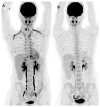PET Molecular Imaging in Breast Cancer: Current Applications and Future Perspectives
- PMID: 38929989
- PMCID: PMC11205053
- DOI: 10.3390/jcm13123459
PET Molecular Imaging in Breast Cancer: Current Applications and Future Perspectives
Abstract
Positron emission tomography (PET) plays a crucial role in breast cancer management. This review addresses the role of PET imaging in breast cancer care. We focus primarily on the utility of 18F-fluorodeoxyglucose (FDG) PET in staging, recurrence detection, and treatment response evaluation. Furthermore, we delve into the growing interest in precision therapy and the development of novel radiopharmaceuticals targeting tumor biology. This includes discussing the potential of PET/MRI and artificial intelligence in breast cancer imaging, offering insights into improved diagnostic accuracy and personalized treatment approaches.
Keywords: FAPI; FDG; FDHT; FES; PET; PET/CT; PET/MRI; androgen receptor (AR); artificial intelligence (AI); breast cancer; deep learning (DL); estrogen receptor (ER); human epidermal growth factor receptor 2 (HER2); machine learning (ML); progesterone receptor (PR).
Conflict of interest statement
The authors declare no conflict of interest.
Figures






References
-
- Sung H., Ferlay J., Siegel R.L., Laversanne M., Soerjomataram I., Jemal A., Bray F. Global Cancer Statistics 2020: GLOBOCAN Estimates of Incidence and Mortality Worldwide for 36 Cancers in 185 Countries. CA Cancer J. Clin. 2021;71:209–249. - PubMed
-
- [(accessed on 20 March 2024)]; Available online: https://www.canceraustralia.gov.au/cancer-types/breast-cancer/statistics.
-
- Taori K., Dhakate S., Rathod J., Hatgaonkar A., Disawal A., Wavare P., Bakare V., Puri R.P. Evaluation of breast masses using mammography and sonography as first line investigations. Open J. Med. Imaging. 2013;3:40–49. doi: 10.4236/ojmi.2013.31006. - DOI
Publication types
LinkOut - more resources
Full Text Sources
Research Materials
Miscellaneous

